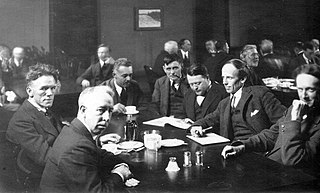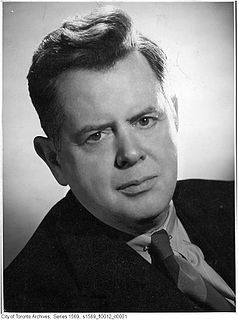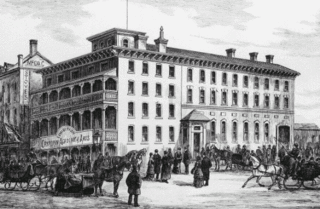
Victoria University is a college of the University of Toronto, founded in 1836 and named in honour of Queen Victoria. It is commonly called Victoria College, informally Vic, after the original academic component that now forms its undergraduate division. Since 1928, Victoria College has retained secular studies in the liberal arts and sciences while Emmanuel College has functioned as its postgraduate theological college.

Sir Frederick Grant Banting was a Canadian medical scientist, physician, painter, and Nobel laureate noted as the co-discoverer of insulin and its therapeutic potential.

Charles Herbert Best was an American-Canadian medical scientist and one of the co-discoverers of insulin.

Trinity College is a college federated with the University of Toronto, founded in 1851 by Bishop John Strachan. Strachan originally intended Trinity as a university of strong Anglican alignment, after the University of Toronto severed its ties with the Church of England. After five decades as an independent institution, Trinity joined the University in 1904 as a member of its collegiate federation.

The Group of Seven, also sometimes known as the Algonquin School, was a group of Canadian landscape painters from 1920 to 1933, originally consisting of Franklin Carmichael (1890–1945), Lawren Harris (1885–1970), A. Y. Jackson (1882–1974), Frank Johnston (1888–1949), Arthur Lismer (1885–1969), J. E. H. MacDonald (1873–1932), and Frederick Varley (1881–1969). Later, A. J. Casson (1898–1992) was invited to join in 1926, Edwin Holgate (1892–1977) became a member in 1930, and LeMoine FitzGerald (1890–1956) joined in 1932.

John George Edward Henry Douglas Sutherland Campbell, 9th Duke of Argyll,, usually better known by the courtesy title Marquess of Lorne, by which he was known between 1847 and 1900, was a British nobleman who was the fourth Governor General of Canada from 1878 to 1883. he was the husband of Princess Louise, fourth daughter of Queen Victoria. He was the first President of "The Rangers Football Club", thanks to his Argyllshire ties to the original founders of the football club.

Sir Ernest Alexander Campbell MacMillan, was a Canadian orchestral conductor, composer, organist, and Canada's only "Musical Knight". He is widely regarded as being Canada's pre-eminent musician, from the 1920s through the 1950s. His contributions to the development of music in Canada were sustained and varied, as conductor, performer, composer, administrator, lecturer, adjudicator, writer, humourist, and statesman.

Louis Applebaum, was a Canadian film score composer, administrator, and conductor.

Hart House is a student activity centre at the University of Toronto. Established in 1919, it is one of the earliest North American student centres. Hart House was initiated and financed by Vincent Massey, an alumnus and benefactor of the university, and was named in honour of his grandfather, Hart Massey. The Collegiate Gothic-revival complex was the work of architect Henry Sproatt, who worked alongside decorator Alexander Scott Carter, and engineer Ernest Rolph, and subsequently designed the campanile at its southwestern corner, Soldiers' Tower.

St. Andrew's College (SAC) is an independent boarding and day school founded in 1899 and located in Aurora, Ontario, Canada. It is a university-preparatory school for boys in grades 5 to 12, with a focus on academic achievement, athletics, and leadership development. It is accredited by the Canadian Educational Standards Institute and is affiliated with other associations, including CAIS, CASE, NAIS and the International Boys' Schools Coalition (IBSC). The school's coat of arms was registered with the Canadian Heraldic Authority on August 15, 2006.

The Royal Canadian Academy of Arts (RCA) is a Canadian arts-related organization that was founded in 1880.

Toronto is the largest city of Canada and one of the most ethnically diverse cities in the world. Many immigrant cultures have brought their traditions languages and music to Toronto.

Margaret Olwen MacMillan is a Canadian historian and professor at the University of Oxford. She is former provost of Trinity College, Toronto and professor of history at the University of Toronto and previously at Ryerson University. Macmillan is an expert on history and international relations.
Violet Rita "Viola" MacMillan was a Canadian mineral prospector and mining financier. During her career, she was one of few women in the mining industry, was the first female member and, later, president of the Prospectors and Developers Association of Canada, and the first woman inducted into the Canadian Mining Hall of Fame.
The Toronto String Quartette (TSQ) was the name of three un-related professional Canadian string quartets based in Toronto, Ontario.

Owen Staples, also known as Owen Poe Staples, was a Canadian painter, etcher, pastelist, political cartoonist, author, musician and naturalist.

The Heliconian Club of Toronto is an association of women involved in the arts and letters based in Toronto, Canada. It operates out of Heliconian Hall located in Yorkville. In existence for over 110 years, the Heliconian Club remains steadfast in its commitment to women living and working in the arts.

The Providence Art Club, Thomas Street, Providence, Rhode Island, was founded in 1880. An art club is an organization for artists and the community to engage and collaborate with each other in a shared space dedicated to art and culture. The Providence Art Club has studios, galleries, eateries, and a clubhouse in a "picturesque procession of historic houses," which are across the street from the First Baptist Church in America.[1] The buildings occupied by the Providence Art Club include Brick House, Dodge House, Deacon Taylor House, and Fleur De Lys Studio.

Guild Park and Gardens is a public park in the Scarborough district of Toronto, Ontario, Canada. The park was formerly the site of an artist colony and is notable for its collection of relics saved from the demolition of buildings primarily in downtown Toronto arranged akin to ancient ruins. Located on the Scarborough Bluffs, Guild Park and Gardens has an outdoor Greek stage and a 19th-century log cabin among the oldest in Toronto. The principal building in the park is the Guild Inn, a former inn and estate mansion.




















